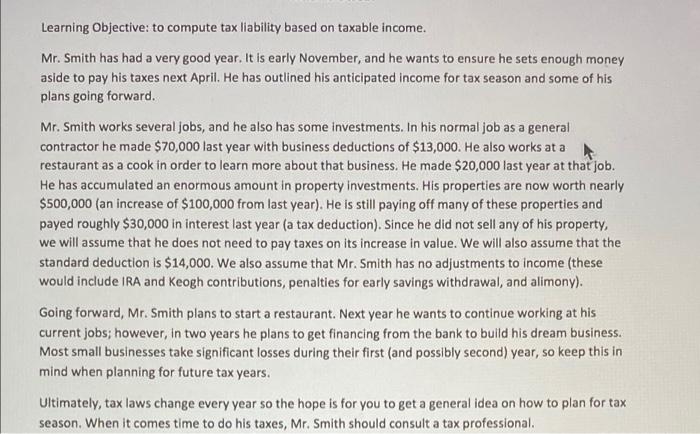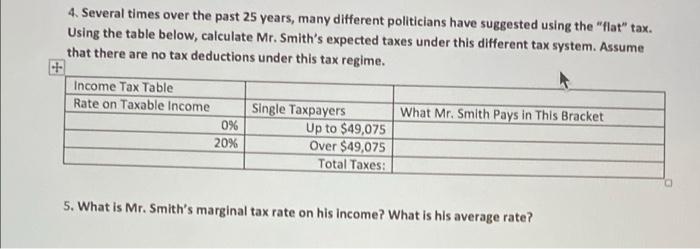Learning Objective: to compute tax liability based on taxable income. Mr. Smith has had a very good year. It is early November, and he wants to ensure he sets enough money aside to pay his taxes next April. He has outlined his anticipated income for tax season and some of his plans going forward. Mr. Smith works several jobs, and he also has some investments. In his normal job as a general contractor he made $70,000 last year with business deductions of $13,000. He also works at a restaurant as a cook in order to learn more about that business. He made $20,000 last year at that job. He has accumulated an enormous amount in property investments. His properties are now worth nearly $500,000 (an increase of $100,000 from last year). He is still paying off many of these properties and payed roughly $30,000 in interest last year (a tax deduction). Since he did not sell any of his property, we will assume that he does not need to pay taxes on its increase in value. We will also assume that the standard deduction is $14,000. We also assume that Mr. Smith has no adjustments to income (these would include IRA and Keogh contributions, penalties for early savings withdrawal, and alimony). Going forward, Mr. Smith plans to start a restaurant. Next year he wants to continue working at his current jobs; however, in two years he plans to get financing from the bank to build his dream business. Most small businesses take significant losses during their first (and possibly second) year, so keep this in mind when planning for future tax years. Ultimately, tax laws change every year so the hope is for you to get a general idea on how to plan for tax season. When it comes time to do his taxes, Mr. Smith should consult a tax professional. 4. Several times over the past 25 years, many different politicians have suggested using the "flat" tax. Using the table below, calculate Mr. Smith's expected taxes under this different tax system. Assume that there are no tax deductions under this tax regime. Income Tax Table Rate on Taxable income 0% 20% What Mr. Smith Pays in This Bracket Single Taxpayers Up to $49,075 Over $49,075 Total Taxes: 5. What is Mr. Smith's marginal tax rate on his Income? What is his average rate? Learning Objective: to compute tax liability based on taxable income. Mr. Smith has had a very good year. It is early November, and he wants to ensure he sets enough money aside to pay his taxes next April. He has outlined his anticipated income for tax season and some of his plans going forward. Mr. Smith works several jobs, and he also has some investments. In his normal job as a general contractor he made $70,000 last year with business deductions of $13,000. He also works at a restaurant as a cook in order to learn more about that business. He made $20,000 last year at that job. He has accumulated an enormous amount in property investments. His properties are now worth nearly $500,000 (an increase of $100,000 from last year). He is still paying off many of these properties and payed roughly $30,000 in interest last year (a tax deduction). Since he did not sell any of his property, we will assume that he does not need to pay taxes on its increase in value. We will also assume that the standard deduction is $14,000. We also assume that Mr. Smith has no adjustments to income (these would include IRA and Keogh contributions, penalties for early savings withdrawal, and alimony). Going forward, Mr. Smith plans to start a restaurant. Next year he wants to continue working at his current jobs; however, in two years he plans to get financing from the bank to build his dream business. Most small businesses take significant losses during their first (and possibly second) year, so keep this in mind when planning for future tax years. Ultimately, tax laws change every year so the hope is for you to get a general idea on how to plan for tax season. When it comes time to do his taxes, Mr. Smith should consult a tax professional. 4. Several times over the past 25 years, many different politicians have suggested using the "flat" tax. Using the table below, calculate Mr. Smith's expected taxes under this different tax system. Assume that there are no tax deductions under this tax regime. Income Tax Table Rate on Taxable income 0% 20% What Mr. Smith Pays in This Bracket Single Taxpayers Up to $49,075 Over $49,075 Total Taxes: 5. What is Mr. Smith's marginal tax rate on his Income? What is his average rate








